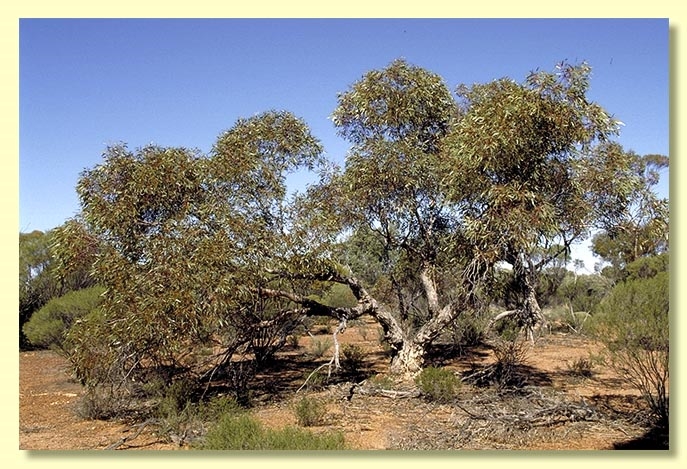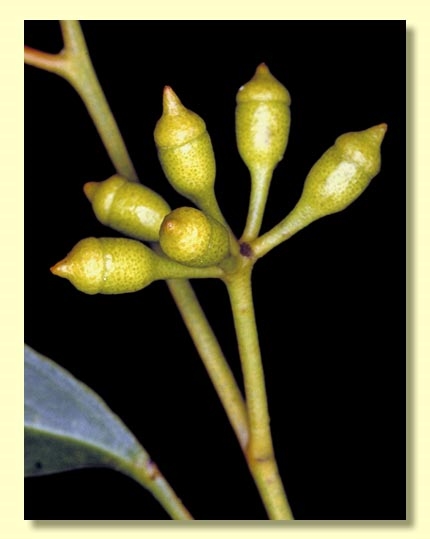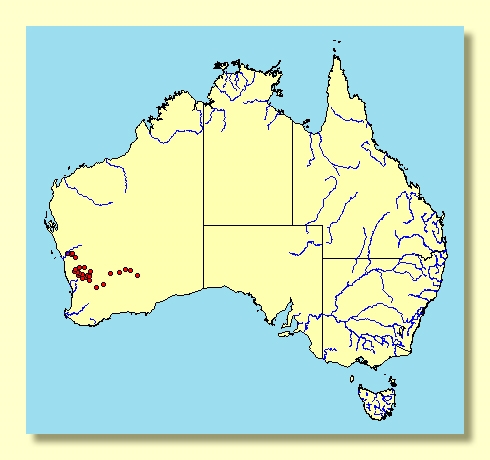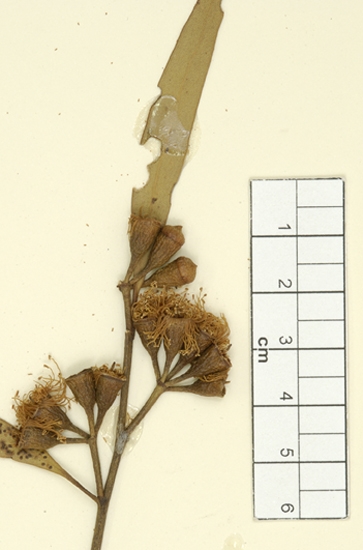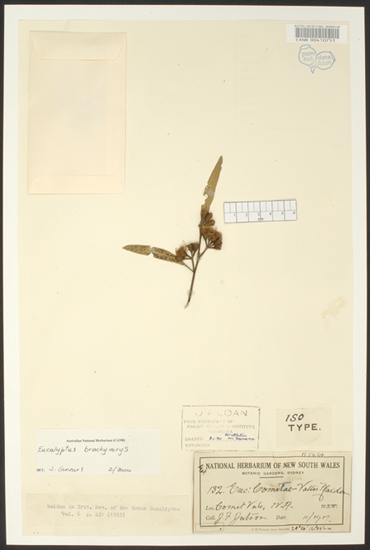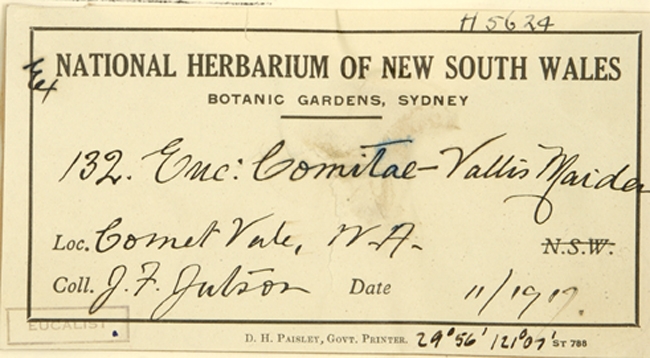Eucalyptus | Symphyomyrtus | Dumaria | Ovulares
Euclid - Online edition
Eucalyptus comitae-vallis
Bark rough, grey, shaggy to ribbony on part or all of trunks to 10 cm diameter branches, or on smaller mallees stems smooth throughout, pinkish grey to whitish and yellow-green.
Branchlets with oil glands in the pith, sometimes only at the nodes, rarely absent.
Juvenile growth (coppice or field seedlings to 50 cm): stems square to rounded in cross-section; leaves always petiolate, alternate, lanceolate, 5.5–8 cm long, 1–2 cm wide, dull, grey-green.
Adult leaves alternate, petioles 0.8–1.5 cm long; blade linear to narrowly lanceolate, 6–10 cm long, 0.6–1.5 cm wide, base tapering to petiole, margin entire, apex pointed, concolorous, slightly glossy to glossy, green, side-veins acute or all venation except midrib obscured by numerous round oil glands.
Inflorescence axillary unbranched, peduncles 0.6–1.2 cm long, buds 7, 9 or 11 per umbel, pedicels 0.2–0.6 cm long. Mature buds cylindrical to narrowly pyriform (0.6–0.9 cm long, 0.3–0.5 cm wide), always with a constriction at join of hypanthium and operculum, scar present, operculum rounded to flattened with a conspicuous but short beak (0.15–0.3 cm long), stamens inflexed, anthers oblong, versatile, dorsifixed, dehiscing by longitudinal slits, style long and straight, stigma broadly rounded to tapered, locules (3)4, the placentae each with 4 vertical rows of ovules. Flowers white.
Fruit pedicellate (pedicels 0.2–0.8 cm long), shortly barrel-shaped to obconical or cupular, 0.5–0.8 cm long, 0.5–0.7 cm wide, disc descending, valves (3)4, at rim level.
Seeds mid-brown, 0.5–1.8 mm long, flattened-ovoid, dorsal surface shallowly and clearly reticulate, hilum ventral.
Cultivated seedlings (measured at ca node 10): cotyledons reniform; stems rounded in cross-section; leaves always petiolate, opposite for 4 to 6 nodes then alternate, narrowly ovate, 3.5–7.5 cm long, 1.5–3 cm wide, dull, grey-green.
Flowering has been recorded in February, March and April.
A Western Australian endemic rough-barked mallee of sandplains in the northern and central wheatbelt east from Mullewa, Coorow, Cowcowing Lakes and Merredin. It also occurs sporadically in the drier goldfields areas further to the east and north, e.g. near Lake Barlee, Menzies, Cosmo Newberry, Queen Victoria Spring.
Eucalyptus comitae-vallis belongs in Eucalyptus sub-genus Symphyomyrtus section Dumaria because the buds have two opercula, stamens are strongly inflexed, ovules are in four rows on the placentae and cotyledons are reniform. Within section Dumaria it belongs to a small sub-group of nine closely related species which are together called series Ovulares. The series is further diagnosed by glandular pith, cuboid anthers, and seeds with a brown shallowly and clearly reticulate dorsal seedcoat.
Some of the species in series Ovulares are completely smooth-barked (E. cyclostoma, E. cylindrocarpa, E. exigua and smaller plants of E. oraria) while others (E. aequioperta, E. baudiniana, E. comitae-vallis, E. myriadena and E. ovularis) have rough bark over at least part of the stems.
E. comitae-vallis is closely related to the spindly mallee E. exigua, which differs in the lower stature, smooth bark and smaller buds and fruit and occurs only east of Hyden; and to E. cyclostoma, which occurs between the Fraser Range and Balladonia and which differs by the smooth bark and much bigger buds and fruit. These three species are characterised by beaked buds which also have a constriction at the base of the operculum. This feature distinguishes them from other species in the series, E. baudiniana, E. myriadena, E. aequioperta, E. oraria and E. cylindrocarpa.
In previous editions of EUCLID Eucalyptus comitae-vallis was referred to as Eucalyptus brachycorys, an error as E. comitae-vallis was the earlier published name.

